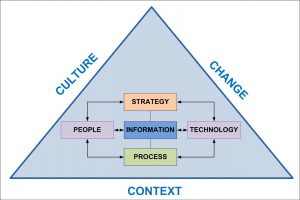The phrase ‘socio-technical’ encapsulates the symbiotic relationship between society (people) and technology, but a socio-technical systems model is needed to understand the relationship.
People and technology do not exist in isolation therefore in order to understand the relationship between them, a broader understanding of the context in which they operate is needed. A socio-technical systems model is proposed here that provides a structure to analyse and design socio-technical systems (figure 1).
Socio-
Technology has limited value if it is not used in society and people will only use technology if it will benefit them in some way. The people component of socio-technical models acknowledges the human element that will use (or reject) the technology. The focus here is on the human characteristics that influence engagement with technology such as knowledge, motivations, values, beliefs, priorities. These are the intangible elements that frustrate and perplex technologists, as elegant technological solutions are rejected. Some of these elements are intrinsic elements, others are derived from the culture, context and strategy of the situation.
-Technology
In the broadest sense, technology is a man-made artefact derived from the application of knowledge. In a world of digitalization, technology is becoming synonymous with information technology; physical devices for digital information creation and consumption. The focus is on technical attributes such as speed, material, design and functionality. Technology is a creation resulting from the socio component, which establishes the first relationship between socio and technical.
Socio-Technical: Requirement Driven
Knowledge is used to design technology that has specific functionality. However, to understand the need for the functionality, the requirements of the technology, we need to understand the task for which the technology will be used. How the task is done will be affected by how people are organized, the structure of communication, authority and duties. The four elements of people, technology, task and structure form Leavitt’s Diamond, recognizing that change in one element may affect the other elements of the model.
Socio-Technical: Interaction Driven
Structures of the task affect how people will use the technology. This has led to work in human-computer interaction which focuses on the interface between people and technology. It seeks to combine analysis of the cognitive processes (socio-) with the physical features of the technology (-technical).
Socio-Technical: Information Driven
People need information to make decisions and take action. Strategy, whether of an individual or an organization, provides the ‘why’; the rationale for doing something. Processes and technology facilitate access to information to meet the needs arising from a specific synthesis of people and strategy within a situation, the information is bounded within a context, culture and any status of change.
The socio-technical systems model reflects:
- who is involved in the situation, the people in the situation and the culture of the individual, people and organization;
- what information is required, the perceptions of information held by people.
- why information is required, the strategy provides the rationale for the information;
- how an individual and technology interact through processes;
- when and where the interaction is required, the context and any potential change being undertaken, provide the context of the interaction.
The inter-relationships between the individual components of the socio-technical systems model are complicated. Attempts to deconstruct the relationships in order to understand the individual elements in the relationship can fail to capture the complexity of the relationship. The complexities emerge from the dynamic interaction between tangible and intangible elements that form the socio-technical context and the conflicting perceptions within it. A greater understanding of the core values that underpin beliefs, directing perceptions and influencing the requirements and interpretation of information is needed. The socio-technical systems model provides a value-driven approach to information management.
Further Reading: A socio-technical systems approach is used to develop an information architecture in Chapter 4.
Please use the following to reference this blog post in your own work:

